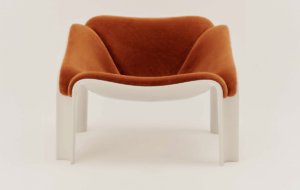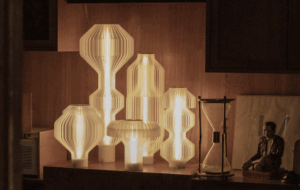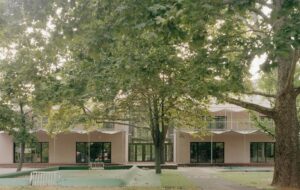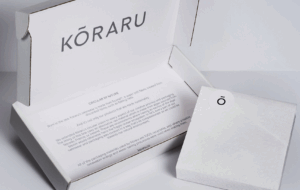

words Marcus Fairs
Moma was once the world’s greatest laboratory of modern art. Now it is merely its greatest repository.
Yoshio Taniguchi’s new home for the Museum of Modern Art on New York’s West 53rd Street is a dazzling white refrigerator dedicated to the preservation of 20th-century visual arts (its collection encompasses design and architecture as well as art). In its sobriety, it tacitly acknowledges that the action has now shifted elsewhere.
For New York is no longer the epicentre of the arts; in fact, it is no longer the epicentre of anything much.
Post 9/11, it feels like a city castrated, a city seeking consolation rather than sensation, a city retreating behind its money. Out-skyscrapered by far-eastern upstarts like Shanghai, out-arted by the vibrant London scene and its liberal elite outflanked politically by Bush’s neocons in Washington, this one-time Babylon now feels like a vast museum dedicated to its own glorious past.
Without the brutal punctuation of the World Trade Center, the skyline appears quaintly Gothic; on the streets, the police cars, taxis and fire-trucks look like props from a 1950s superhero movie. Districts that were once bohemian crucibles for cultural trends that influenced the whole world now feel like tourist ghettoes: SoHo is about as edgy as Covent Garden; Greenwich Village is as twee as Le Marais.
MoMA might have a monumental new home but, like its host city, its greatest days are behind it. It was founded in 1929 – the year of the Wall Street Crash, and the year Manhattan’s most distinctive architectural masterpiece, the Chrysler building, was being erected.
The MoMA story has been endlessly (and breathlessly) retold in the past few months as the museum’s pre-reopening hype machine got into gear: how its founder, Alfred H Barr, effectively invented the notion of modern art and helped establish Modernism as the dominant cultural movement of the last century; how MoMA’s gravitational pull helped New York replace Paris as the centre of the art universe.
MoMA quickly became Modernism’s mothership, as the world’s avant-garde was drawn to Jazz-age New York – then the most exciting and liberal place on earth. For much of the last century, New York was a hyper-strength cultural electromagnet, drawing misfits and pioneers and refugees. Everyone from Duchamp to Warhol was sucked into its delirious canyons.
The city managed to hang on to its creative pre-eminence until late in the 20th century although, one by one, it lost its grip on a descending scale of art forms. Great architecture ceased happening here in the Seventies (Philip Johnson’s Chippendale-topped AT&T tower of 1979-1984 – Post Modernism’s pre-eminent gag – was the last Manhattan building of real note) and the art scene hasn’t been the same since the deaths of Warhol (1986) and Basquiat (1988). The hip hop and graffiti scene of the late Eighties was the last globally influential cultural movement to come out of the city (and one that has deteriorated from an expression of collective ghetto anger into a vapid bling celebration of sex and shopping).
The most recent world-sweeping New York phenomenon was a TV series – Sex and the City – which, when its Blahniks-and-brunch plotlines expired last year, left the city immortalised by George Gershwin, Woody Allen, Tom Wolfe and Lou Reed without an essential voice for the first time in almost a 100 years.
9/11 did not cause this cultural slump, but it explosively confirmed it. The void at Ground Zero has become the most potent symbol of New York’s cultural menopause.
And so back to the new MoMA. “The city has grown up since the Modern shut its doors to build its new home two and a half years ago,” wrote New York Times architecture critic Nicolai Ouroussoff a few days before the museum reopened in November last year. “The hole left by the twin towers. A war in Iraq. A polarized electorate. Our culture is in a crisis as critical as any since the cold war period when Modernism reached its final, exuberant bloom. That may be the reason why the new Modern seems so comforting.”
For “comforting”, read “predictable”. Putting the world’s greatest assembly of 20th-century art in a building that harks back to the outmoded Modernist ideals of that century is a bit like commissioning a faux-Victorian cabinet to house your collection of Coronation mugs.
For $850 billion – the cost of the building, the temporary home in Queens and a healthy endowment – MoMA’s private patrons have bought themselves a vast mausoleum both for the works of mostly dead artists, and for their own good names, thanks to the silver letterings that spell out their generosity in “The Patricia and Gustavo Cisneros Gallery” and “The Donald B and Catherine C Marron Atrium”. And they’re charging hoi polloi $20 for the privilege of seeing the fruits of their exquisite good taste.
In his opening address at the media preview – attended by perhaps 1000 journalists, and feeling more akin to a presidential press conference – MoMA director Glenn Lowry was at pains to stress that the museum was still a laboratory, was still at the cutting edge of charting the evolution of art.
But earlier, John Elderfield, MoMA’s head curator of paintings and sculpture, suggested otherwise. “As it is the only collection that can tell the story of modern art, there’s an obligation to do that,” he told me, hinting that the museum’s primary role was now to interpret and represent the past. “It’s part of our backing away from the vogue,” he added, in reference to the decision to ignore contemporary movements such as the BritArt phenomenon.
Taniguchi, a serene and humble 67-year-old, has built a series of exquisite concrete cultural buildings in his native Japan but this was his first international commission.
His obscure eastern pedigree allowed MoMA and its old-money donors to sidestep the appointment of the more challenging avant-garde names that dominated the competition longlist (sample: Rem Koolhaas, Wiel Arets and Steven Holl) while avoiding accusations of lazy conformity (they could have chosen Richard Meier, after all).
Much has been made of MoMA’s brave decision to ignore the recent fad for whimsically shaped cultural buildings, but Taniguchi was appointed in 1997, the year Gehry’s trend-setting Guggenheim in Bilbao opened. Thus MoMA was either so foresighted that it was able to buck the trend before the trend had been established, or it is cleverly spinning the fact that it misread the architectural zeitgeist.
Or perhaps it had simply lost interest in the cutting edge. Taniguchi’s appointment was an exercise in comfort-seeking conventionalism dressed up as a quest for profundity. Taniguchi is a modernist but, since he is from Japan, MoMA was able to sell him – very successfully – as some kind of Zen figure with near-mystical powers.
Hence many critics who have reviewed MoMA have bought wholesale the guff about walls that appear to float (they don’t – they merely have shadow gaps at top and bottom), about how Taniguchi has fused urbanism and architecture (by putting doors on both 53rd and 54th street, thereby providing a shortcut between the two) and the way his incisions create new relationships between works in different galleries and a dialogue with the city beyond (via the use of devices more commonly known as “windows”).
“I don’t give any strong sculptural quality,” the modest and thoughtful Taniguchi explained to me when I bumped into him on the museum’s fifth floor.
Taniguchi is not the type to make portentous claims for his work. Instead, he said: “I tried to give a sequence of spaces so you don’t get tired of looking at paintings. You see layers of space … and views.”
Taniguchi’s building is very big and very clever (and quite beautiful in places, notably the suicide atrium) but most of its intelligence and budget has gone into resolving a dastardly site (it is punctured by a dorkish Cesar Pelli tower and constrained by preservation-order fragments of the original museum) into an unencumbered, but extremely traditional, museum space.
Unlike Tate Modern (whose turbine hall has become a stage for vast artworks such as Anish Kapoor’s Marsyas or Olafur Eliasson’s Weather Project), or the Bilbao Guggenheim (where the building itself is Exhibit A), MoMA sticks with hanging paintings on the wall and plonking an extremely predictable selection of design classics (Dieter Rams’ 606 shelving, Gerrit Rietveld’s Red and Blue chair, yawn) on a plinth.
The building is most remarkable for the way such expensive materials, such as the black Zimbabwean granite of the facade, have been put to such invisible use. You can hardly see the building, either from the street or within.
The ostensible point of this extravagant subtlety is to direct your eye to the art, not the building. But really, MoMA’s intention is to overawe the visitor with feelings of inferiority. Having paid your $20, you are supposed to say: “My, look how many of the really great paintings MoMA has! Look how many rich benefactors it has! What a swell museum and what a swell city!”
Whereas, in fact, MoMA is the definitive art museum of the last century, in the definitive city of the last century.

















